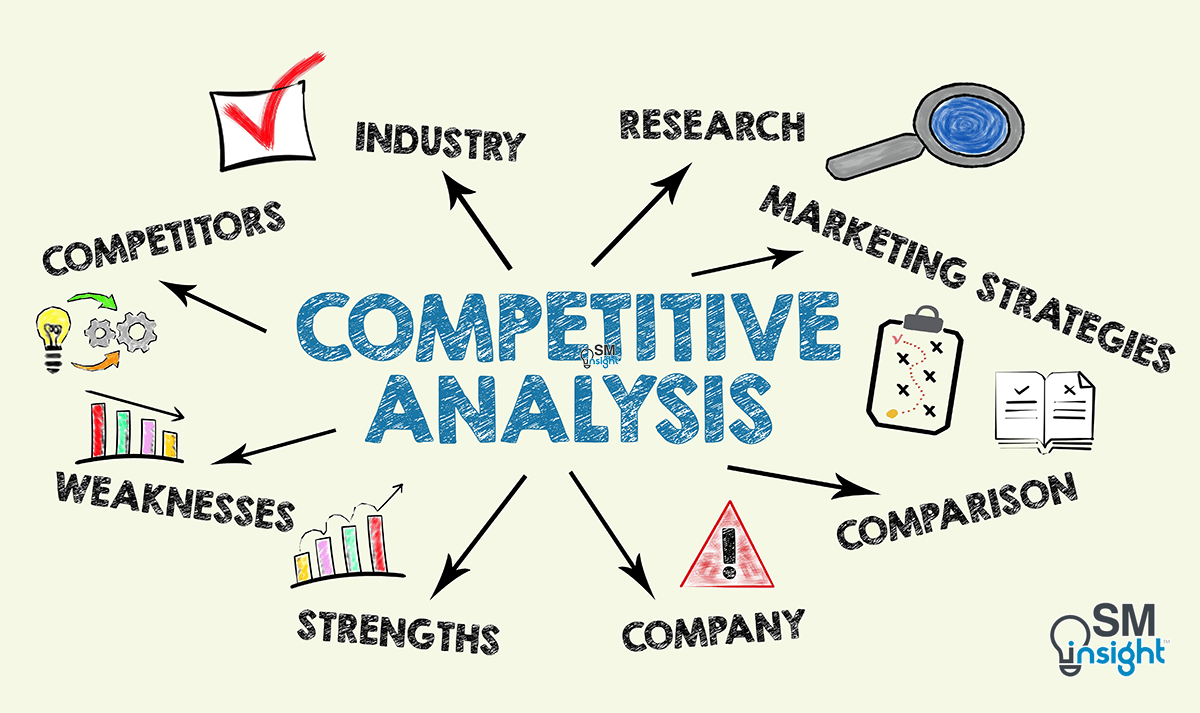In the highly competitive world of online business, understanding your competitors is more crucial than ever to boost your conversion rates and achieve sustainable growth. Mastering competitor analysis provides valuable insights into what works—and what doesn’t—in your industry, allowing you to fine-tune your strategies and stay one step ahead. By systematically examining your competitors’ strengths, weaknesses, and customer engagement tactics, you can uncover hidden opportunities to optimize your own website’s performance. In this blog post, we’ll guide you through the essential steps of conducting a thorough competitor analysis and show you how to leverage these insights to drive more conversions and maximize your ecommerce success.
1. Understanding the Importance of Competitor Analysis in CRO
Understanding the importance of competitor analysis in Conversion Rate Optimization (CRO) is crucial for businesses aiming to maximize their online performance. Competitor analysis allows you to gain valuable insights into what strategies are working well in your industry and identify opportunities where your own website can improve. By studying your competitors’ strengths and weaknesses—such as their website design, user experience, pricing models, and promotional tactics—you can uncover gaps in the market and tailor your CRO efforts accordingly. This not only helps you stay ahead of the competition but also ensures that your optimization initiatives are data-driven and targeted. Ultimately, incorporating competitor analysis into your CRO process empowers you to make informed decisions that enhance user engagement, boost conversions, and drive sustainable growth for your business.

2. Identifying and Selecting Your Key Competitors
Identifying and selecting your key competitors is a crucial first step in mastering competitor analysis for effective conversion rate optimization (CRO). To begin, start by pinpointing businesses that operate within your niche and target the same audience as you. These competitors are not just those who offer similar products or services but also those who rank highly in search engine results, run successful advertising campaigns, or have a strong presence on social media platforms. Utilize tools like SEMrush, Ahrefs, or SpyFu to uncover which companies are bidding on your key keywords and attracting your potential customers. It’s equally important to differentiate between direct competitors, who offer the same product or service, and indirect competitors, who serve the same need in a different way. By carefully selecting a manageable number of primary competitors—typically three to five—you can conduct a more focused and actionable analysis. This targeted approach allows you to gain insightful data on their conversion strategies, user experience, pricing models, and unique value propositions, ultimately guiding you to refine your own CRO tactics and outperform them in the marketplace.
3. Tools and Techniques for Effective Competitor Research
Conducting thorough competitor research is a cornerstone of effective conversion rate optimization (CRO). To gain valuable insights into your competitors’ strategies, it’s essential to leverage the right tools and techniques. Start by using website analysis tools like SEMrush, Ahrefs, or SimilarWeb to uncover your competitors’ traffic sources, top-performing keywords, and backlink profiles. These platforms provide a wealth of data that helps you understand what’s driving their online success. Additionally, heatmapping tools such as Hotjar or Crazy Egg allow you to study user behavior on competitor websites, revealing how visitors interact with their pages and where they focus their attention. Social media monitoring tools like BuzzSumo or Sprout Social can also help identify popular content and engagement tactics your competitors use to connect with their audience. Beyond tools, performing a detailed SWOT analysis (Strengths, Weaknesses, Opportunities, Threats) can help you contextualize your findings and spot gaps in the market. Combining these methods equips you with a comprehensive understanding of your competitive landscape, allowing you to tailor your CRO strategies for maximum impact.
4. Analyzing Competitor Strategies: Strengths and Weaknesses
Analyzing your competitors’ strategies is a crucial step in mastering conversion rate optimization (CRO). By closely examining what your competitors are doing well, you can identify best practices and innovative tactics that resonate with your shared target audience. Look at their website design, user experience, call-to-action placements, pricing structures, and promotional campaigns to uncover elements that contribute to their success. At the same time, it’s equally important to pinpoint their weaknesses—areas where they fall short or customer pain points that remain unaddressed. Perhaps their site navigation is confusing, their checkout process is cumbersome, or they lack personalized messaging. Understanding these gaps presents valuable opportunities for your business to differentiate itself and craft a superior user journey. Ultimately, a thorough competitor analysis provides actionable insights that empower you to refine your own strategies, enhance user engagement, and boost conversion rates.
5. Applying Competitor Insights to Optimize Your Conversion Rates
Applying competitor insights to optimize your conversion rates is a strategic approach that can significantly enhance your marketing efforts. By thoroughly analyzing what your competitors are doing well—and where they fall short—you can identify opportunities to differentiate your offerings and refine your customer journey. Start by examining their website design, messaging, call-to-actions, and overall user experience. Are there elements that seem to engage visitors effectively or drive conversions? Take note of their pricing strategies, promotional offers, and customer reviews to understand what resonates with your shared target audience. Leveraging these insights, you can tailor your landing pages, optimize your value propositions, and implement tested conversion tactics that align with your brand identity. Remember, the goal is not to copy but to learn and innovate, turning competitor data into actionable steps that improve your conversion rates and ultimately boost your bottom line.
6. Monitoring and Adapting Your Strategy for Continuous Improvement
Monitoring and adapting your strategy is a crucial step in mastering competitor analysis for effective conversion rate optimization (CRO). The digital landscape is constantly evolving, and what works today may not yield the same results tomorrow. By consistently tracking your performance metrics alongside those of your competitors, you can identify emerging trends, spot potential gaps, and uncover new opportunities to enhance your conversion rates. Utilize tools like Google Analytics, heatmaps, and competitor benchmarking platforms to gather real-time data on user behavior, traffic sources, and engagement levels. However, data alone isn’t enough — the key lies in interpreting these insights and being agile in your approach. Regularly revisit your CRO strategies, test new hypotheses through A/B testing, and don’t hesitate to pivot when something isn’t delivering the expected results. This ongoing cycle of monitoring, learning, and adapting ensures that your marketing efforts remain competitive, responsive, and optimized for continuous improvement over time.

7. Common Mistakes to Avoid in Competitor Analysis for CRO
When conducting competitor analysis for Conversion Rate Optimization (CRO), it’s crucial to avoid common pitfalls that can undermine your efforts and lead to misguided strategies. One of the most frequent mistakes is focusing solely on superficial metrics like website traffic or social media followers without delving deeper into user behavior, conversion funnels, and customer experience. Another error is copying competitors blindly—what works for one brand might not resonate with your unique audience or align with your value proposition. Additionally, neglecting to update your analysis regularly can render your insights outdated, especially in fast-evolving markets. Failing to consider qualitative data such as customer reviews and feedback also limits your understanding of competitors’ strengths and weaknesses. Lastly, overlooking your own website’s analytics in favor of competitor data can cause you to miss critical opportunities for internal improvement. By steering clear of these mistakes, you’ll ensure your competitor analysis is both strategic and actionable, paving the way for more effective CRO initiatives.
8. Future Trends in Competitor Analysis and Conversion Optimization
As the digital landscape continues to evolve at a rapid pace, future trends in competitor analysis and conversion rate optimization (CRO) are set to become more sophisticated and data-driven than ever before. One of the most significant shifts will be the increasing integration of artificial intelligence and machine learning technologies. These tools will enable businesses to analyze vast amounts of competitor data in real-time, uncovering deeper insights into consumer behavior, market shifts, and emerging opportunities. Additionally, predictive analytics will play a crucial role, helping marketers anticipate competitor moves and optimize their conversion strategies proactively rather than reactively.
Another key trend is the growing importance of personalized user experiences. As consumers demand more tailored interactions, competitor analysis will extend beyond surface-level metrics to include granular user journey mapping and sentiment analysis. This nuanced understanding will empower businesses to fine-tune their conversion funnels, ensuring they resonate more effectively with target audiences. Moreover, the rise of voice search, augmented reality, and other emerging technologies will open new avenues for CRO, requiring companies to adapt their strategies accordingly.
Finally, ethical considerations and data privacy will increasingly influence how competitor data is gathered and utilized. Marketers will need to balance the pursuit of competitive advantage with transparency and compliance, fostering trust with their customers. By staying ahead of these trends, businesses can harness the full potential of competitor analysis to drive smarter, more effective conversion rate optimization in the years to come.

If you found this article helpful and need help with your website conversion, contact us for a FREE CRO Audit



